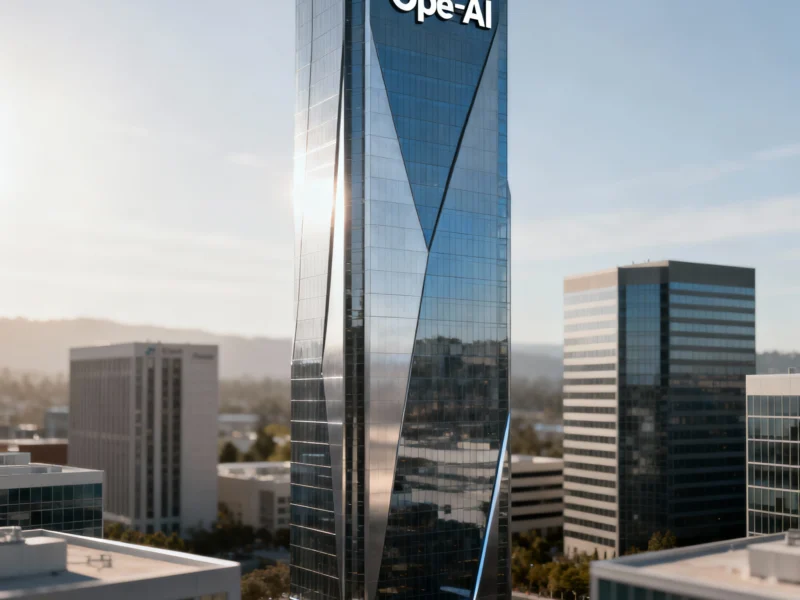OpenAI’s dominance represents a paradigm shift in Silicon Valley’s power structure, combining unprecedented scale, secretive financials, and vertical integration that challenges traditional startup dynamics. With a staggering $500 billion valuation and partnerships spanning from the White House to Nvidia, the AI lab is rewriting the rules of tech competition while maintaining private ownership that shields its operations from public scrutiny.
The Unprecedented Scale of OpenAI’s Expansion
In under three years, OpenAI has transformed from a promising AI research organization into a technological behemoth investing “up and down the stack” from data center infrastructure to consumer applications. The company’s flagship ChatGPT now serves 800 million weekly users, while recent product launches like Sora AI video app achieved 1 million downloads in under five days. This explosive growth trajectory dwarfs previous tech giants’ expansion timelines.
CEO Sam Altman has orchestrated a series of massive infrastructure agreements with industry leaders including Nvidia, Broadcom, Oracle, and AMD. These partnerships position OpenAI to control critical components of the AI ecosystem, from chip design to cloud computing infrastructure. The company’s data center buildout plan, endorsed by the White House, represents one of the largest private infrastructure investments in recent memory.
Entrepreneurial Challenges in the OpenAI Era
“It’s the fastest-moving time in startup creation and disruption in my 17 years of investing,” observed Ethan Kurzweil, managing partner at Chemistry Ventures. This sentiment reflects the unique challenges facing today’s entrepreneurs who must navigate OpenAI’s expanding footprint across multiple technology domains.
Nina Achadjian, a partner at Index Ventures who focuses on AI investments, captures the prevailing uncertainty: “If you’re an entrepreneur, you have to ask yourself, ‘Where is the white space?'” Her firm’s recent $25 million investment in Quilter, which uses AI for printed circuit board design, demonstrates how investors are seeking opportunities in specialized niches unlikely to attract OpenAI’s immediate attention.
- Vertical specialization – Companies focusing on narrow technical domains
- Hardware integration – Startups combining AI with physical products
- Enterprise solutions – B2B applications serving specific industries
OpenAI’s Strategic Moves and Product Ecosystem
The past months have witnessed an acceleration in OpenAI’s strategic initiatives, including:
- Launch of Codex software engineering agent for general availability
- Integration of Sora 2 into API for developer testing
- Partnership with iPhone designer Jony Ive on AI hardware development
- $6.4 billion talent acquisition program attracting top industry figures
This aggressive product rollout coincides with major infrastructure investments that position OpenAI to control both the foundational AI models and the computing resources required to run them. The company’s willingness to spend “other people’s money” at unprecedented scale creates competitive advantages that traditional startup companies cannot match.
Investment Strategies in the Shadow of AI Giants
Venture capital firms are adapting their investment theses to account for OpenAI’s expanding influence. As Achadjian noted regarding her Quilter investment, some opportunities remain “pretty niche” and “not built on top of any model,” making them less vulnerable to competition from AI giants.
The Quilter Series B funding represents a strategic bet on specialized AI applications in hardware design, where established players like Cadence Design and Synopsys provide competitive moats. This approach reflects broader trends in AI investing toward domains requiring deep technical expertise and existing industry partnerships.
Additional coverage from our network examines how major tech companies are acquiring AI talent and the broader defense technology landscape intersecting with AI development.
The Future of Competition in AI-Dominated Markets
OpenAI’s private ownership structure and secretive financial operations create what Achadjian describes as an environment with “no predictability.” Unlike publicly traded competitors, OpenAI can pursue long-term strategies without quarterly earnings pressure, while its partnership with visionaries like Ray Kurzweil-inspired technologists suggests ambitions extending beyond current product categories.
The company’s hardware initiatives with Jony Ive remain deliberately vague, with Ive telling Altman he hopes to develop tools that “make us happy and fulfilled and more peaceful.” This philosophical approach to product development contrasts with the rapid-fire product releases elsewhere in OpenAI’s portfolio, suggesting multiple strategic timelines operating simultaneously.
As Silicon Valley adjusts to this new competitive reality, entrepreneurs and investors must navigate both the immediate threats and unexpected opportunities created by OpenAI’s unique position at the center of the AI revolution.



